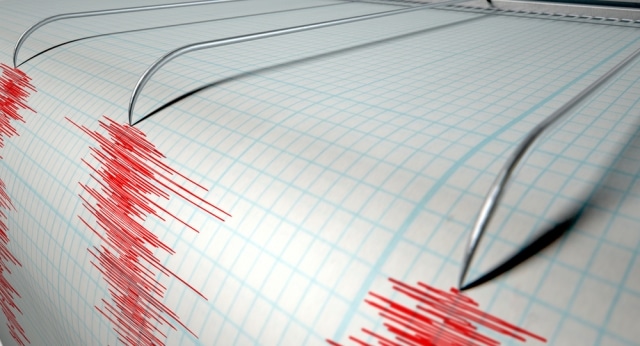The evidence establishing that the oil and gas industry is causing earthquakes grew much stronger last week, as two scientific papers clarified exactly how human activity is driving the swarm of quakes that has afflicted Oklahoma for the past six years.
For decades, earthquakes were rare in the central US. Since the 1970’s, two dozen quakes over magnitude 3.0 shook the region in an average year and larger quakes were even more rare.
But since 2009, right when the drilling industry’s wastewater production started spiking, the number of earthquakes has been skyrocketing, with 688 quakes that size hitting the region in 2014 — and 2015 is on track to be even more seismically active.
This means, Oklahoma has been hit by more quakes in the past year and a half than were felt in the entire 36 year-span from 1973 through 2008.
Just because two patterns emerge at the same time, that doesn’t necessarily mean they are linked. But for the past several years, federal and academic research has pointed to the oil and gas wastewater as the cause. The new research bolsters that case, especially since one of the papers was authored by a Stanford professor who also works as a senior oil industry consultant.
The “unprecedented” increase in earthquakes occurred almost exclusively within a 10-mile radius of wastewater disposal wells that inject the fluids deep underground, the first paper, published in the journal Science, found.
The second study, published in Science Advances and authored the Stanford professor, took a close look at the mechanics of how the wastewater disposal wells cause quakes, answering technical questions that have dogged researchers about the timing of quakes compared to when injection wells pump in the most wastewater.
“We expect California to have a lot of earthquakes, but not Oklahoma — but now, Oklahoma is having more earthquakes than California,” F. Rall Walsh III, a doctoral student at Stanford who also worked on the second paper, told LiveScience.
The findings might be unsurprising to many Oklahomans living in the newly quake-prone region.
A 4.2 magnitude quake struck northwestern Oklahoma and reached in Kansas on the day before the papers were published. And although a 3.0 quake can be felt but generally does little damage, a 4.0 magnitude quake can damage buildings and homes.
“We were getting at least one a day, sometimes two or three earthquakes a day,” Sharon McDonald of Guthrie Oklahoma told a local television station as she explained how her foundation and walls had cracked from the shaking. “My house is crumbling around me and there’s nothing I can do about it.”
Meanwhile, oil production in Oklahoma nearly doubled from the time the quake swarm began in 2009 to 2014 — rising to 128,000 barrels last year. And the amount of wastewater produced has spiked right along with the oil, hitting over a million barrels of wastewater last year.
In other words, for every gallon of oil drilled in the region, roughly 10 gallons of wastewater are injected below ground.
Oil and gas companies have vehemently denied that their wastewater is responsible for the sudden uptick, arguing that natural forces are to blame.
“The Earth has been moving continuously over time, and that movement is the result of natural tectonic forces far away but that express themselves right here,” Tim George, an attorney for XTO, told the Dallas Morning News earlier this month.
But the new evidence shows that quakes are mainly becoming more common very near wastewater injection sites — not randomly across the state as might be expected if natural forces were to blame.
“It’s not just that more earthquakes are happening — more earthquakes are happening preferentially near injection wells,” team leader Matthew Weingarten, a doctoral candidate at the University of Colorado at Boulder, and the lead author of the paper published in Science, told Nature.
In fact, at ten percent of the 180,000 oil and gas industry wells studied, quakes later occurred within the 10 mile radius, the researchers found. And the areas around wells that pumped in huge volumes were up to twice as likely to suffer earthquakes later.
In fact, 87 percent of the quakes that struck the region in 2014 were within the ten-mile ring — up from 20 percent in 2000.
“We saw an enormous increase in earthquakes associated with these high-rate injection wells, especially since 2009, and we think the evidence is convincing that the earthquakes we are seeing near injection sites are induced by oil and gas activity,” Mr. Weingarten said in a press release.
The Stanford study helped to answer one of the more difficult questions surrounding how the oil wastewater is tied to quakes. The evidence suggests that the faster wastewater is injected, the more likely it is for earthquakes to strike nearby — but sometimes quakes don’t begin for months or even years after injection rates peak.
Why the delay?
The answer, Prof. Mark Zoback and Mr. Walsh concluded, has to do with the pressures in two rock layers deep underground in the central US — the Arbuckle formation, long a favorite injection site for oil wastewater, and the layer right below it where quake-causing faults are found, the crystalline basement.
Earlier this year, Oklahoma state regulators ordered injection well operators to provide proof that their wastewater was not directly hitting the crystalline basement out of concern over the quakes.
But pressure in the Arbuckle over time can also affect the crystalline basement and its many faults, and ultimately causing a quake, the model developed by Zoback and Walsh predicts. In fact, the researchers said, the added pressure from wastewater is simply speeding up the rate at which faults slip, making them happen over years instead of millennia.
“The earthquakes in Oklahoma would have happened eventually,” Walsh explained. “But by injecting water into the faults and pressurizing them, we’ve advanced the clock and made them occur today.”
The fact that it can take time for the pressure in the Arbuckle to affect the crystalline basement means that it would take a while for quakes to stop even if a ban on injection was put into place overnight.
“They’ve already injected so much water that the pressure is still spreading throughout the Arbuckle formation,” Zoback said in a Stanford press release. “The earthquakes won’t stop overnight, but they should subside over time.”
Zoback is the Benjamin M. Page Professor in Stanford’s School of Earth, Energy & Environmental Sciences. He also currently serves as a Senior Executive Adviser to Baker Hughes, one of the world’s largest oilfield services companies. At Stanford, he has proved a controversial figure, as students protested his empanelling as an investment advisor on environmental issues, citing his role at Baker Hughes and his position as the director of the Stanford Natural Gas Initiative, labeling it a conflict of interest.
“I’m a strong advocate for responsible oil and gas development,” Zoback told The Journal Record. “But I don’t think what is happening in Oklahoma is sustainable.”
Zoback emphasized that much of the wastewater in Oklahoma comes from conventional oil and gas drilling, not from fracking. “It is not caused by the hydraulic fracturing process at all,” he told CNBC, laying the blame at the feet of oil drillers who tapped water-laden oil reserves.
But earlier this year, a cascade of earthquakes in Ohio were directly linked to fracking — not wastewater disposal — and the study in Science, which examined quakes outside of Oklahoma included earthquakes in regions where wastewater often comes from fracking.
And nationwide, the sheer amount of wastewater being pumped into the ground by the oil and gas industry is believed to have spiked, especially because of high-volume hydrofracking and the shale oil and gas rush. But because there are no uniform national laws covering how that waste is handled or even measured, the specific amount cannot be stated with certaintly.
One thing is clear: if the vast amounts of wastewater generated by onshore oil and gas drilling cannot safely be injected underground, the oil and gas industry will face a massive bottleneck.
“I don’t know how many more studies would be enough to convince the oil and gas industry that their practices are dangerous,” Jesse Coleman, a researcher at Greenpeace told Yahoo News. “Nobody really knows what to do with the now-contaminated water.”
Photo Credit: “A closeup of a seismograph machine needle drawing a red line on graph paper depicting seismic and earthquake activity on an isolated white background,” via Shutterstock
Subscribe to our newsletter
Stay up to date with DeSmog news and alerts







